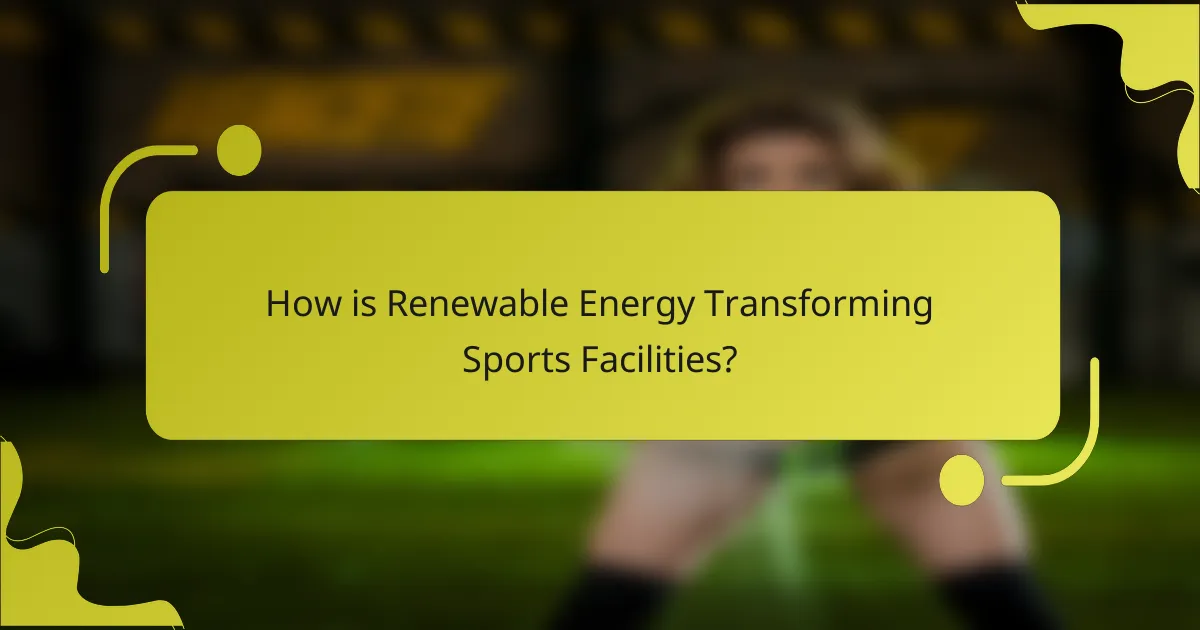Renewable energy is reshaping the sports industry by enhancing sustainability and reducing operational costs. This article explores applications of renewable energy in sports, highlights benefits such as lower carbon footprints, and examines case studies from organizations like the NFL and the International Olympic Committee. It also addresses challenges faced in implementation and emerging trends in energy technologies.

How is Renewable Energy Transforming Sports Facilities?
Renewable energy is transforming sports facilities by reducing carbon footprints and operational costs. Many venues now utilize solar panels, wind turbines, and geothermal systems to power their operations sustainably. For instance, the Mercedes-Benz Stadium in Atlanta employs a combination of solar energy and rainwater harvesting, achieving LEED Platinum certification. This shift not only enhances environmental stewardship but also attracts eco-conscious fans and sponsors, showcasing a unique commitment to sustainability in sports.
What are the most common renewable energy sources used in sports venues?
The most common renewable energy sources used in sports venues include solar, wind, and geothermal energy. Solar energy is often harnessed through photovoltaic panels, providing electricity for lighting and facilities. Wind energy can power venues with turbines, while geothermal systems offer efficient heating and cooling solutions. These sources reduce carbon footprints and operational costs, enhancing sustainability in sports.
How do energy-efficient designs impact operational costs in sports facilities?
Energy-efficient designs significantly reduce operational costs in sports facilities by lowering energy consumption. These designs often incorporate renewable energy sources, such as solar panels, which can decrease electricity expenses. For instance, facilities that utilize energy-efficient lighting and HVAC systems can save up to 30% on energy costs annually. Additionally, sustainable materials and construction practices may lead to lower maintenance costs over time. As a result, investing in energy-efficient designs not only enhances sustainability but also improves the financial performance of sports facilities.
Which technologies are leading the way in renewable energy applications for sports?
Solar energy, wind power, and energy storage technologies are leading renewable energy applications in sports. These technologies enhance sustainability by reducing carbon footprints and operational costs.
Solar panels are widely used in stadiums for energy generation. For instance, the Mercedes-Benz Stadium in Atlanta utilizes a solar array, contributing to its LEED certification. Wind turbines are also being integrated, such as those at the University of Delaware’s sports facilities, which harness wind energy for electricity.
Energy storage systems, including batteries, are essential for managing energy supply and demand. They allow sports venues to store excess energy generated during peak production times. This capability improves energy efficiency and reliability, especially during events.
Overall, these technologies not only support environmental goals but also provide economic advantages, making them vital in the sports industry.

What are the Environmental Benefits of Renewable Energy in Sports?
Renewable energy in sports significantly reduces carbon footprints and promotes sustainability. It lowers greenhouse gas emissions, enhances energy efficiency, and supports eco-friendly practices. For example, solar panels on stadiums can power facilities, reducing reliance on fossil fuels. Wind turbines can provide clean energy for events, showcasing a commitment to environmental stewardship. Additionally, utilizing renewable energy sources can lead to cost savings in the long term, benefiting organizations financially while supporting global climate goals.
How does using renewable energy contribute to carbon footprint reduction in sports?
Using renewable energy significantly reduces carbon footprints in sports by minimizing greenhouse gas emissions. Renewable sources like solar, wind, and hydroelectric power generate energy without depleting resources or polluting the environment. For example, stadiums powered by solar panels can cut energy costs and lower carbon emissions by up to 50%. Transitioning to renewable energy not only enhances sustainability but also sets a positive example for fans and communities. Furthermore, organizations that adopt renewable energy often benefit from enhanced public image and increased support from environmentally conscious sponsors.
What role does renewable energy play in sustainable sports event management?
Renewable energy significantly enhances sustainable sports event management by reducing carbon footprints and operational costs. It supports energy efficiency through solar panels, wind turbines, and biofuels. For instance, using solar energy can lower electricity expenses by up to 30%. Case studies, such as the use of renewable sources in the 2016 Rio Olympics, demonstrate effective implementation. This approach not only promotes environmental responsibility but also attracts eco-conscious sponsors and attendees.

Which Sports Organizations are Pioneering Renewable Energy Initiatives?
Several sports organizations are leading renewable energy initiatives. Notable examples include the International Olympic Committee, which aims for carbon neutrality by 2030, and the NFL, which has committed to using 100% renewable energy in its facilities. Other organizations like the NBA and FIFA are also implementing sustainable practices, such as solar energy installations and energy-efficient stadium designs. These initiatives not only reduce carbon footprints but also promote environmental awareness among fans and communities.
What case studies highlight successful renewable energy implementations in sports?
Several case studies demonstrate successful renewable energy implementations in sports, showcasing innovative solutions. The Mercedes-Benz Stadium in Atlanta utilizes a 1.6 MW solar array, significantly reducing its carbon footprint. The U.S. Open Tennis Championships have integrated solar panels, providing renewable energy for operations. Additionally, the Levi’s Stadium in California features a 400 kW solar installation, making it one of the greenest stadiums in the world. These examples highlight the growing trend of sustainable practices in sports facilities, enhancing environmental responsibility while reducing operational costs.
How do different regions approach renewable energy in sports organizations?
Regions approach renewable energy in sports organizations by integrating local resources and policies. For example, Europe emphasizes wind and solar energy, while North America focuses on diverse renewable sources, including biomass and geothermal.
In Asia, countries like Japan utilize innovative technologies, such as hydrogen fuel cells, to power sports facilities. Australia showcases a unique attribute by implementing large-scale solar installations at major sporting events, enhancing sustainability.
Collaboration between governments and sports organizations often drives these initiatives, leading to significant reductions in carbon footprints and operational costs. As a result, renewable energy in sports not only promotes environmental responsibility but also fosters community engagement and support.

What Challenges Do Sports Organizations Face in Implementing Renewable Energy?
Sports organizations face several challenges in implementing renewable energy, including high initial costs and infrastructure limitations. These entities often need substantial investment for solar panels or wind turbines, which can deter adoption. Additionally, existing facilities may not be designed to integrate renewable technologies effectively. Regulatory hurdles and varying energy policies can complicate the transition. Lastly, a lack of awareness or expertise in renewable energy solutions can hinder decision-making processes within these organizations.
What are the financial barriers to adopting renewable energy in sports?
High initial costs, lack of funding, and uncertain return on investment are key financial barriers to adopting renewable energy in sports. Many sports organizations struggle to secure upfront capital for renewable projects. Additionally, fluctuating energy prices can deter long-term investments. Case studies show that public-private partnerships can alleviate some financial burdens, promoting wider adoption.
How do regulatory frameworks affect renewable energy projects in sports?
Regulatory frameworks significantly influence renewable energy projects in sports by dictating compliance, funding, and operational standards. These regulations can either facilitate or hinder the adoption of sustainable practices within sports organizations. For example, incentives such as tax credits encourage investment in solar and wind energy solutions. Conversely, stringent regulations may create barriers, impacting project viability. Ultimately, a supportive regulatory environment fosters innovation and investment, leading to enhanced sustainability in sports.

How Can Fans and Athletes Benefit from Renewable Energy in Sports?
Fans and athletes can benefit from renewable energy in sports through reduced costs and enhanced sustainability. Renewable energy sources like solar and wind power lower operational expenses for venues, allowing funds to be redirected to athlete development and fan experiences. Additionally, utilizing clean energy promotes environmental responsibility, attracting eco-conscious fans and sponsors. Case studies show stadiums powered by renewable energy achieve higher attendance and improved community relations.
What initiatives promote fan engagement with renewable energy practices?
Initiatives that promote fan engagement with renewable energy practices include educational campaigns, interactive events, and partnerships with eco-friendly organizations. These efforts encourage fans to adopt sustainable habits. For example, some sports teams host renewable energy workshops, while others incorporate solar power in stadiums, showcasing the benefits of green energy.
How does renewable energy influence athlete performance and well-being?
Renewable energy positively influences athlete performance and well-being by providing cleaner, sustainable energy sources. This reduces environmental stressors and enhances training facilities, leading to improved physical and mental health. For example, solar-powered gyms offer better air quality and lower energy costs, allowing athletes to focus on performance. Additionally, using renewable energy fosters a sense of responsibility and community engagement among athletes, promoting overall well-being.

What Future Trends are Emerging in Renewable Energy for Sports?
Emerging trends in renewable energy for sports include increased solar installations, wind energy utilization, and energy-efficient technologies. These innovations enhance sustainability and reduce operational costs for sports facilities. For instance, stadiums are adopting solar panels to power operations, while some are integrating wind turbines to harness natural energy sources. Additionally, advancements in energy storage solutions are improving energy management in sports venues.
How are innovations in renewable energy shaping the future of sports events?
Innovations in renewable energy are transforming sports events by enhancing sustainability and reducing carbon footprints. Many venues now utilize solar panels and wind turbines to power facilities, significantly lowering energy costs.
For instance, the 2020 Tokyo Olympics featured a commitment to sustainability, with 100% of the energy coming from renewable sources. This shift not only reduces environmental impact but also sets a precedent for future events.
Additionally, electric transportation options are becoming standard, further promoting eco-friendly practices. As a result, sports organizations are increasingly prioritizing renewable energy to attract environmentally conscious fans and sponsors.
The integration of these technologies reflects a growing trend in the sports industry toward sustainable development, showcasing the potential for renewable energy to shape the future of sports events.
What role will renewable energy play in the next generation of sports infrastructure?
Renewable energy will significantly enhance the sustainability and efficiency of future sports infrastructure. By integrating solar panels, wind turbines, and energy-efficient systems, sports facilities can reduce carbon footprints and operational costs. For instance, the Mercedes-Benz Stadium in Atlanta utilizes a combination of solar energy and rainwater harvesting, showcasing a successful case study in renewable energy application. Additionally, renewable energy sources can power stadiums during events, ensuring a reliable energy supply while promoting environmental responsibility.
What best practices can sports organizations adopt to maximize renewable energy use?
Sports organizations can maximize renewable energy use by implementing several best practices. First, they should conduct energy audits to identify areas for improvement. Next, investing in solar panels and wind turbines can significantly reduce reliance on non-renewable sources. Utilizing energy-efficient systems for lighting and HVAC also contributes to sustainability. Additionally, engaging fans through educational campaigns about renewable energy fosters a supportive community. Finally, forming partnerships with renewable energy providers can enhance access to green energy solutions.




